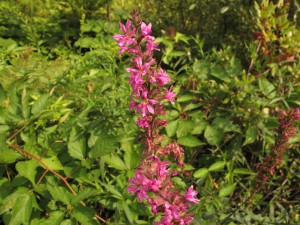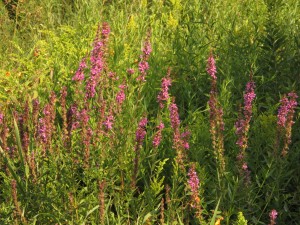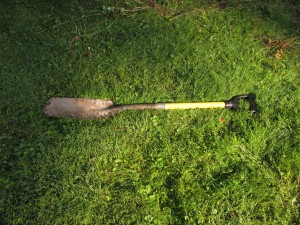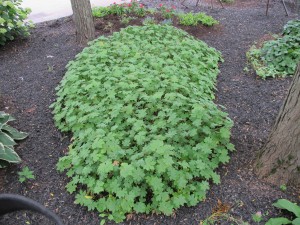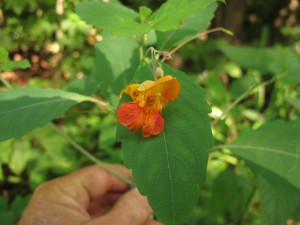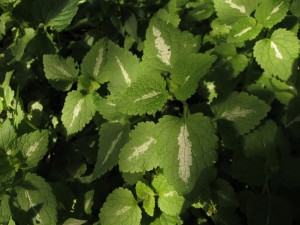Keeping a Taste of the Garden to Eat This Winter
Every year the vegetable garden produces food for me. Some years I have enough to eat and to share – with plenty left to put up for the winter. But every year is different and this year my garden is a bit of a disappointment. Here it is the end of August and I’m not able to gorge on tomatoes the way I usually do. And although I only planted one zucchini plant this year, so far I’ve only harvested just one zucchini. Still, I will put some produce in the freezer, just not as much as I’d like.
For those gardeners with plenty, let’s take a look at some easy ways to put produce aside for use this winter. First, tomatoes: freeze them whole. Just put clean, dry tomatoes into freezer bags and suck the air out with a straw after closing the bag 99% of the way. Use them this winter in soups and stews the way you would canned tomatoes. Knowing that they are your own makes them even better. You can use them with the skins on, if you wish, but running hot tap water over the frozen tomatoes and rubbing gently will remove them.
In past years I have always dehydrated cherry tomatoes in my Garden Master Pro dehydrator after cutting them in half. The result is a “sun dried” tomato that is sweet and wonderful for stir fries and soups. But last summer I tried putting some in the freezer whole and liked them for cooking. I just throw the whole frozen cherry tomatoes in soups and they are great – and much less work than drying them.
Each year I use imperfect tomatoes to make paste. I cut out the bad parts, throw them in the food processor, and puree them. Then I boil down the resulting slurry in a heavy cast iron enameled pot until I can literally stand up a spoon in it. That takes all evening at low heat. I leave it overnight, cover off, and in the morning I spoon the paste into ice cube trays and freeze it. Later I put the cubes in freezer-grade zipper bags.
Many people don’t bother freezing summer squash and greens – or even green beans and broccoli because they’ve had bad luck with the results: mushy, overcooked veggies. But there are a few simple steps you can take to have wonderful, fresh-tasting crunchy vegetables in mid-winter – that were grown in your own garden.
Many vegetables taste better, mid-winter, if they have been blanched –briefly boiled – before freezing. Blanching is way of killing aging enzymes in veggies so that the produce put in the freezer does not get woody, old and tasteless. But many “experts” suggest blanching fresh veggies for 3 minutes, or even more. In my book, that is fully cooking them. And when you cook them again before eating,the result is mush.
The solution? Blanch for just 60 seconds or so. Depending on your stove, that may mean not even getting the water back up to a full boil. The trick is to have lots of water at a rolling boil, and not too many veggies. I watch the color of my vegetables as I blanch them. Kale, for example, will turn a brighter green – telling me that it’s ready to take off the heat.
It’s important to cool your blanched vegetables as soon as they come out of the pot. Some experts recommend dropping them in a big bowl of water with ice cubes. Me? I’m too cheap to buy ice cubes in the quantity I would need. I just fill the sink with cold tap water, and it works just fine. Next I spin dry the veggies in a salad spinner with a string-pull (Zyliss brand in one) and blot dry with tea towels before bagging and putting in the fridge.
My exceptions to blanching include tomatoes, peppers and all berries. Everything else gets a quick swim in boiling water. Last year a kind reader suggested that kale need not be blanched, so I tried freezing some without blanching. It was fine, but less kales fit into each bag.
Dehydrating fruits and vegetables is another good way to store food, particularly if you don’t have much freezer space. Apples and pears dry nicely and make for good winter snackage. Even if you don’t grow your own, you can buy/pick fresh apples cheaper than buying dried fruit. I dry apples and pears until they are dry, but not brittle. I store them in freezer grade bags in the pantry.
Peppers and tomatoes, sliced, dry well and are great in winter soups and stews. I dry most of my hot peppers until brittle and then grind them in my coffee grinder. That allows me to add just a smidgeon of hotness if having company – or a lot if it’s just for me. I have read that the seeds and the white fibers inside the pepper contain a lot of capsaicin, the chemical that gives hot peppers their heat, so I dry those, too.
I’ve gotten a lot of e-mail from discouraged gardeners this year. It wasn’t a great year for many of us. But there are still farm stands selling fresh produce, and often they will sell cheaply by the bushel if you want to store food for the winter. I may end up doing so myself.
Send questions, suggestions and laments to Henry by e-mail at henry.homeyer@comcast.net or by mail at P.O. Box 364, Cornish Flat, NH 03746. Please include a stamped envelope if you wish an answer by mail.
Dealing with Invasives
I’m sure you know purple loosestrife, even if you don’t know its name. It’s a big, tall clumping plant bearing bright pinkish-purple flowers and it’s appearing now in your neighborhood, especially in wet areas. What you may not know is that it’s an aggressive foreign invader that can out-compete many of our native species. It has been around for a couple of centuries – it came over, allegedly, in soil used as ballast in sailing vessels in the late 1700’s.
But if it grows well and it’s pretty, what’s the problem, you may wonder? A number of things. It’s a big plant that can dominate the landscape and shade out smaller, less vigorous native plants. A mature loosestrife can produce up to a million seeds, seeds that can be carried by streams to new locations. Wildlife can be negatively impacted. Many insects and birds depend on native plants for food and nesting materials- native plants that evolved with them. Invasives like purple loosestrife often do not meet their needs.
According to Barbara McIlroy of Etna, NH, who has been active in the movement to control invasive species, the number of bird and butterfly species present on properties that grow native species is much, much higher. “I’m converted,” she told me. “Grow natives. Period. The positive effect on the wildlife is dramatic.”
Unfortunately, it’s almost impossible to rid your property of purple loosestrife. These plants have amazingly tenacious roots. Before I knew better I tried digging out some large plants from a swampy area on my property. Yes, I got the plants out – but some of the roots broke off and re-sprouted. And by clearing out a space, I also opened up a new site for seeds to grow. If you have had purple loosestrife in the past, there are seeds waiting for a chance to germinate – like little time bombs.
But there is good news: two species of beetle (Galerucella calmariensis and G. pusilla) have been approved for and found effective in controlling purple loosestrife. These beetles cannot eliminate the loosestrife, but can reduce the numbers dramatically. Loosestrife is not a problem in Europe the way it is here, in part because it has natural enemies – the beetles. By introducing the beetles, an effort has been made to help Mother Nature keep loosestrife under control. Once established, they eat enough of the leaves and stems that the plants do not bloom. And theses beetles have been well tested: they will not eat your garden plants or valuable crops.
In 2001 Saint-Gaudens National Historic Site in Cornish, NH released two species of beetles to see if they could control the purple loosestrife that was taking over the wetlands at Blow-Me-Down pond. I met recently with Steve Walasewcz, who monitored the effort from 2001 to 2008. He explained that the beetles did not have an immediate effect. In fact, from 5.75 stems per square meter in 2001, the numbers increased to 10.5 by 2003. But then they declined each year until reaching only 1.05 in 2008 – a tenth the number of stems.
I went to the area where the beetles were released in 2001 and although there were a few blooming stems of purple loosestrife, there were very few. According to a report done for Saint-Gaudens NHS, it is believed that even low numbers of beetles prevent flowering; at higher numbers, “the beetles can strip the plants of its photosynthetic layer, resulting in high mortality in the winter due to a depleted starch reserve.”
Unfortunately, the beetles are not readily available for purchase. But for several years I have been experimenting with my own way of controlling the problem near my brook. Each year in early July I take pruners and cut back the plants to the ground. I identify them by their square stems that have a reddish color near the ground, and of course their leaves. Then a month later, I do it again – in essence, acting like a beetle. By cutting back the plants, few are able to bloom, greatly reducing the number of seeds spilling into my environment.
As a second step, I planted some big, tall native plants that I hoped would compete with the purple loosestrife: Joe Pye weed (Eupatorium purpureum) and Canadian burnet (Sanguisorba canadensis). I also added marsh marigold (Caltha palustris), which though not tall, is tough. These natives have given purple loosestrife a run for its money. Instead of filling 3 wheelbarrows with cut loosestrife in early July, I was able to get it all in one.
Purple loosestrife is just one of many invasive plants. If you see a new, vigorous plant show up on your property, try to learn its name and find out if it’s a problem elsewhere. Meanwhile, there is good news: scientists are working on biological controls for both Japanese knotweed (commonly called bamboo) and garlic mustard. In England, certain beetles are now well established to reduce the vigor of Japanese knotweed.
Henry Homeyer is the author of 4 gardening books and a new children’s fantasy-adventure about a boy and a cougar. His web site is www.Gardening-guy.com.
What To Do When Company is Coming
I’ve got company coming this weekend, and I want my gardens to look nice. I can’t make them perfect, but here are some of the things I’m doing – and that you can, too, whether company is coming or if you just want to get on top of garden tasks.
First of all, I am getting rid of all the tall weeds. A flower bed with 4-foot tall weeds is much less attractive than a flower bed with the same number of short things creeping around the bed. So golden rod that towers over the daylilies is much more of a problem than 6-inch tall creeping Charlie that scurries around their base.
Now a big clump of goldenrod can be a fearsome opponent. It holds on fiercely. But if you are truly in a hurry, you can fix the problem – in the short term- by cutting it off with pruners or a sharp serrated knife. That makes it disappear to the casual viewer. Later, when you have more time, you can dig up that big clump of tenacious weeds with a shovel.
Next I am buying some plants to fill in spaces. Each year a few perennials die over the winter, and I try to replace them each spring and summer. But this year was so wet that I never got around to doing so. There are places where, I must admit, some flower beds have patches of pure weeds. Nothing but weeds. As I weed them out, I am discovering spaces where I can plant new things.
I recently was at a Farmers market and saw a beautiful purple-blue perennial known as a speedwell or veronica. (Veronica spicata). It was in full bloom and magnificent with 16 inch spikes of small flowers. I should have purchased three, but was unsure how much space (and money) I had, so I only bought one. Maybe next week there will still be some left and I can buy more. I had a nice spot in mind for it.
This is the time of year when daylilies are particularly lovely, so next I went to Cider Hill Gardens in Windsor, VT to look through their selection. I bought some nice ‘spider’ daylilies. These are a type that differs from standard daylilies by having longer petals that are spaced farther apart – almost like the legs on a spider. I planted them with the veronica – a very nice contrast.
You can divide most flowers almost any time of the year (except peonies, which should only be done in the fall). I had a big clump of a late fall-blooming clear yellow daylily that, over time, was being overshadowed (literally) by a multi-stemmed shrub known as common ninebark, a variety called ‘Diablo’. Diablo has dark purplish leaves and grows fast. Very fast. Each year- right after it blooms in June – I cut off about two feet from each stem to keep it under control. But each year the shrub sends up more stems from the ground, expanding its diameter. And so this wonderful daylily was being crowded.
I used a drainspade to dig up that big daylily. This is a spade about 16 inches long and 6 inches wide. I pushed the spade into the soil at a 45 degree angle in 4 places around the perimeter. Each time it was fully inserted into the ground, I pushed down on the handle, lifting the clump a little. On the fourth and final push, I pried it out and carried it away.
At this time of year annuals are in short supply in most garden centers, but if you can find some, they are a great addition to the garden because most will bloom until frost. Just cut them back if they look ratty, and give them some liquid fertilizer.
Until recently, my window box by the front door was pretty pathetic. I yanked a lackadaisical dahlia and replaced it with a colorful pink ‘Superbena’. Superbenas are hybrids of annual verbenas that do very well in hot, dry locations like window boxes.
Potted plants can be used to spiff up the garden, too. I generally move all my potted plants outside in the summer, placing them on the north-facing deck. But when company comes, I am not above moving a few of the larger ones into the garden. I am careful not to put them in full sun, however, as they’ve been in a fairly shady location all summer and I could easily sunburn the leaves if I put them in too much sun. A nice clivia or papyrus in a decorative pot can be a nice addition to an otherwise drab location.
Last but least, mow the lawn the day before your mother-in-law or college roommate arrives. A well cut lawn is pleasing to the eye, especially if you use a push mower to go in all the corners, or use a string trimmer to do the edges. And it’s even okay to pay someone to do it. Then sit back, relax, and enjoy your property with your guests.
Henry Homeyer’s web site is www.Gardening-Guy.com. His is the author of 4 gardening books and a children’s book: Wobar and the Quest for the Magic Calumet.
Labor Savers
As I get older – I’m 67 – I sometimes wonder how long I will be able to keep on gardening at the level I do now. I have a large vegetable garden, fruit bushes and trees, many flower beds, a variety of decorative trees and shrubs – and some lawn. I have already accepted that it makes more sense to have a teenager mow the grass and to help me with some of the heavier drudgery of the garden. I am looking at ways to make less work for myself, and thought I might share a few labor-savers with you.
In the vegetable garden, mulch is my friend. It’s mid-summer, and some beds I have weeded more than once because I have not paid attention to my own dictum that mulching saves a lot of labor. But this has been a soggy summer, and there have been many days when I could not get in the garden because the ground was water-logged. And some days I almost could have kayaked down the pathways of my garden. So I did not get my mulching done early. Even when I could have mulched, I didn’t because soil looses more moisture when exposed to the sun, and I needed to let the soil dry out.
This past week I have made a real effort to weed the vegetable garden and put down mulch. My basic technique is to weed, then cover the area weeded with something to keep the sun from reaching weeds that surely will germinate. I like newspapers covered with straw or mulch hay. Six pages of this paper covered with straw will prevent most weeds and grasses from growing. This year I got some jute coffee bags to use for mulching the pathways, and I like them, too.
Weeds in walkways can spread to the beds by root or seed, so keeping them weed-free is a great boon to the tired or over-ambitious gardener. Last fall I planted grass seed in some rows, and mow it. But the width of the mower required that I space beds farther apart than I usually do. And it is awkward to get the mower around corners of rows. So it is not a perfect solution, though it looks great if you have the space to maintain nice mowed paths.
It’s tough to find good weeders to help. But a teenager can do a nice job if you just teach her to identify and pull one or two particular species of troublesome weeds. So I have someone just working on jewelweed, also called touch-me-not (Impatience capensis). It is a tall weed with orange or yellow flowers and a hollow, watery stem. It generally grows in shade or part shade. It’s not a perennial so it has a relatively small root system that pulls easily.
Jewelweed’s other common name, touch-me-not, does not indicate any poisonous properties. It has to do with the fact that ripe seed pods have built-in springs that will propel seeds some distance. Lightly squeeze a pod, and good-sized green seeds go flying.
For the past decade I‘ve been ignoring touch-me-not because my grandchildren enjoy squeezing the pods. Doing so always provokes a giggle. But over time, more and more touch-me-not has appeared, and recently I declared war on it. The plants are just starting to bloom for me, so I must get them – now! This will not preclude having some plants next year or the year after, as most seeds of garden plants are good for 3 years (and weed seeds may last even longer). There must be plenty of seeds already in my soil. So Rule #1 of reducing work in the garden: Get rid of weeds before they scatter their seeds.
Some groundcovers can be great weed inhibitors in flower beds. Others spread so fast that they become weed-like themselves. If you want to plant groundcovers, be sure to weed the area well before planting them. Get not only the tops of your weeds, but their roots as well. Use a weeding tool that can get underneath a weed, loosen the soil, and lift the entire root system. I like the CobraHead weeder for that task.
There are lots of good groundcovers – too many to mention them all here. For dry shady areas, I like dead nettles (which I call by its scientific name, Lamium, because it is not related to stinging nettles). It has pink or white flowers reminiscent of snapdragons, and some varieties have nice silver and green leaves. It spreads and grows densely enough to keep many weeds from starting up under and between the plants.
Bigfoot geranium (Geranium macrorrhizum) is another good one. It’s not related to your mother’s potted red geranium (which is actually not a geranium but a Pelargonium). It makes a very dense mound of leaves a foot tall or more. It blooms in early summer, but I grow it for the foliage and because it shades out most things. And it will grow in dense, dry shade – or full sun.
Lungwort (Pulmonaria spp.) spreads by root in either sun or shade, as does lily of the valley (Convalaria majalis). I like the former, but find the latter a bit too aggressive to keep.
There are many ways to save labor, but most important of all is getting rid of any weed that is blooming now. It will save you labor later.
Henry Homeyer is a gardening consultant and the author of 4 gardening books. His Web site is www.Gardening-Guy.com.




